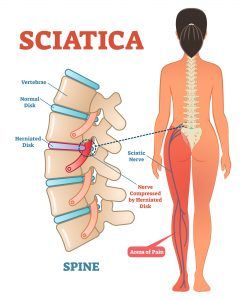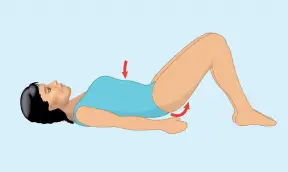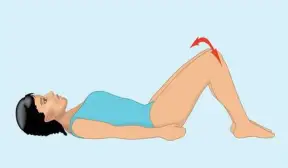
How To Help Sciatica at Home
 Did you know that up to 40% of people will experience sciatica at some point in their lives? Sciatica pain is impossible to ignore and even harder to live with. The sharp, shooting pain can be felt from your lower back to your buttocks or down your leg into your foot.
Did you know that up to 40% of people will experience sciatica at some point in their lives? Sciatica pain is impossible to ignore and even harder to live with. The sharp, shooting pain can be felt from your lower back to your buttocks or down your leg into your foot.
Sciatic nerve pain results from pressure or inflammation on the sciatic nerve—the longest nerve in the body. Injury or irritation are both common causes.
The good news is that sciatica doesn’t have to be a permanent part of your story. In fact, most cases of sciatica resolve within six weeks—without intervention. So, let’s look closer at how you can alleviate sciatica at home.
3 Home Remedies for Sciatica
Consider these simple remedies that support your body and relieve sciatica pain—all in the privacy and comfort of your own home.
1. Keep Moving
Strange as it sounds, one of the best things you can do for sciatica pain is to keep moving. Moderate activity helps prevent muscle spasms and encourages blood flow, which promotes healing and reduces inflammation. You’re also less likely to notice your sciatica pain when you’re moving—just don’t overdo it.
2. OTC Medication
While not long-term solutions, over-the-counter pain medication and NSAIDs (non-steroidal anti-inflammatory drugs) are effective pain relief options. They’re especially helpful if the pain interferes with your sleep. If you have high blood pressure or Asthma always check with your Pharmacist or G.P first before taking.
3. Heat and Ice
For the first few days of your sciatica pain, apply ice packs to the area for 20 minutes, several times a day, to reduce inflammation. After that, alternate heat and ice—this generally helps relieve the pain, loosens tight muscles, and encourages blood flow, which all tend to support healing.
The 3 Best Stretches for Sciatica
Another effective way to treat and prevent sciatica is to stretch your lower back and improve the flexibility of your spine. These stretches are so simple, you do all of them lying down!
Note: Tension is normal, but don’t continue with a stretch if it causes pain.
1. Knee to Chest
 Lying flat on your back, gently “hug” one knee into your chest for about 10 seconds. Alternate knees and repeat three to five times. Then, hug both knees into your chest and hold for 10 seconds.
Lying flat on your back, gently “hug” one knee into your chest for about 10 seconds. Alternate knees and repeat three to five times. Then, hug both knees into your chest and hold for 10 seconds.
This simple stretch targets the lower back and lengthens your spine, which relieves pressure on your nerves.
2. Pelvic Tilt
 To do the pelvic tilt, lie on your back with your knees bent and feet on the floor. Aim to flatten your spine by pushing your belly button down towards the ground. To do this, you’ll notice your pelvis has to tilt towards your ribs. Hold the position for five seconds and repeat at least 10 times.
To do the pelvic tilt, lie on your back with your knees bent and feet on the floor. Aim to flatten your spine by pushing your belly button down towards the ground. To do this, you’ll notice your pelvis has to tilt towards your ribs. Hold the position for five seconds and repeat at least 10 times.
This stretches your lower back and builds strength in your core—which also supports your spine.
3. Lower Trunk Rotations
 Lie on your back with your knees bent together and your feet on the floor. Keep your back flat on the floor and slowly lean your knees towards one side for five seconds. Then, lean them to the other side. Repeat this 10 times.
Lie on your back with your knees bent together and your feet on the floor. Keep your back flat on the floor and slowly lean your knees towards one side for five seconds. Then, lean them to the other side. Repeat this 10 times.
This simple movement increases the flexibility of your lower spine.
3 Lifestyle Changes that Prevent Sciatica
There are healthy everyday things you can do to prevent the recurrence of sciatica nerve pain. These include the following.
1. Stay Active
Exercise is an investment in your overall health and helps prevent sciatica pain.
It encourages a healthy posture and weight loss, which lessens the pressure on your spine and reduces the risk of sciatica. A weak core fails to provide the support your spine needs. To combat this, include core-strengthening exercises in your routine.
2. Walk Tall and Sit Less
Poor posture is another serious culprit when it comes to sciatica. Avoid slouching when you sit, and where possible, avoid sitting for too long.
Hold your head high and push your chest out when you walk—this naturally restores the shape of your spinal column, which prevents unnecessary pressure on your nerves.
3. Lift Carefully
If you need to bend and lift things often, keep your spine straight and bend at your knees. When you do bend, don’t twist sideways. Additionally, always make sure you engage your core to protect your back!
Consider Chiropractic Care for Sciatica Pain
Sciatic nerve pain doesn’t have to linger. Moving, strengthening, and stretching your body at home can all contribute to a healthy spine and a pain-free back.
If your sciatic nerve pain doesn’t resolve after a short period, schedule an appointment with one of our chiropractors today. Our team at Chatfield Chiropractic is passionate about spinal health; as such, our team offers holistic and personalised treatment plans to help you heal and live pain-free. Together, we can help you get back to your normal!
